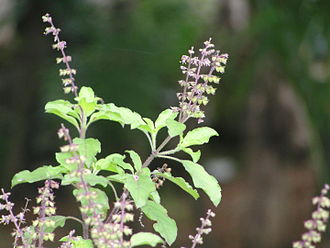
Family: Labiatae
Habitat / place of origin
It is considered indigenous to the Indian subcontinent including the Himalayas, Malesia, and other tropical and subtropical parts of Asia.
Biological classification
- Kingdom: Plantae
- Subkingdom: Viridiplantae
- Infrakingdom: Streptophyta
- Superdivision: Embryophyta
- Division: Tracheophyta
- Subdivision: Spermatophytina
- Class: Magnoliopsida
- Order: Lamiales
- Family: Lamiaceae
- Genus: Ocimum L.
- Species: Ocimum tenuiflorum L.
Introduction To Tulsi
Ocimum sanctum commonly known as holy basil, tulsi or tulasi, is an aromatic perennial plant in the family Lamiaceae. This plant is cultivated for religious and traditional medicine purposes, and also for its essential oil. It is widely used as a herbal tea, commonly used in Ayurveda, and has a place within the Vaishnava tradition of Hinduism, in which devotees perform worship involving holy basil plants or leaves. Tulsi is one of the best plants for purifying indoor air quality as it absorbs many toxic chemicals like xylene, formaldehyde and benzene.

Synonyms of Tulsi
Sanskrit : Tulsi , Sursa , Apetrakshi , Devdudubhi .
Assamese: Tulsa , Tutsi.
Bengali: Tulasi.
English: Holy Basil.
Gujarati: Tulasi.
Hindi: Tulsi.
Kannada: Shritulsi.
Kashmiri: Tulsi.
Malyalam: Trittavu.
Marathi: Tulsa.
Oriya: Dhala Tulasi.
Punjabi: Tulsi.
Tamil : Tulsi.
Telugu: Tulsi.
Morphology of Tulsi
Erect, many branched shrub 30-60cm tall
Stem : Hairy stem
Leaves : Green or purple simple , petioled with ovate blade up to 5cm long usually slightly toothed
Flower: Purplish in elongated recemes in closed whorls
Fruit: Have flattened seeds of red or yellow coloured
Flowering time: Winter season
Fruiting time : Winter season
Medicinal Parts of Tulsi
Leaves , Root , Seeds
Plant variety of Tulsi
Mainly it has two varieties :
- Shweat (white): leaves and branches are green ,
- Botanical name : O. americanum
- Krishan (black): leaves and branches are purplish in colour . it is best variety .
There are two more varieties other than this these:
-
- Rama tulsi = O. grantissimum
- Kapori tulsi= O. kilimandscharium
Chemical Composition of Tulsi
- Oleanolic acid, rosmarinic acid , eugenol , carvacrol , linalool , am=nd beta – caryophyllene
- Essential oils are eugenol , beta -elemene , beta-caryophyllene and germacrene
Ayurvedic Properties of Tulsi
Rasa (Taste) : Katu , Tikta
Guna (Quality) : Laghu , Ruksha
Virya (Potency) : Ushna
Vipak (Post Digestive Effect): Katu
Seeds are snigdha and shitta properties
Karma (Pharmacological Actions)
Dosha Karma : Kapha-Vata Shamak , Pitta Vardhak
Sansthanik Karma(General Indications): Jantughan , Durghandhnashak , Utejak , Vatahar, Shothhar
Pachnasansthan (Digestive System ): Deepan , Pachan , Anuloman, Kirimighan
Rakvahsanthan (Cvs): Hridya Uttejak , Raktshodhak , Shothhar
Sawsan-Sansthan (Respiratory System ): Kaphhanghan
Mutravahsansthan (Urinary System): Mutral
Twacha (Skin): Jawarghan , Specially Vishamjawar
Seeds Are Balya .
Qualities/Effects on Tridosha of Tulsi
It reduces the kapha and vata dosha by ushna virya and due to this it also increases the pitta dosha
Formulations of Tulsi
- Tulsi capsules
- Feverex syrup
- M-cof syrup
- Respicare tablets
- Pneumonorum syrup
- B. Cough
Therapeutic Uses of Tulsi
- It is used in kapha -vataj diseases
- Indicated in headache and rhinitis
- Also in cough , asthma
- Indicated in back pain
- It in indicated in anorexia , vomiting ,stomach pain, and in worm infestations
- Seeds indicated in dysentery
- It is indicated in old wound , swelling , and in pain
- Indicated in blood disorders
- Indicated in kidney stones , inflammation in urethra , dysuria
- Useful in leprosy
- Indicated in viral fever like malaria and dengue etc.
Dosage
- Swaras = 10-20ml
- Kwath= 50-100ml
- Seed powder= 3-6gm
How can you consume Tulsi?
It is administered as directly in the form of juice and it is used in many formulations . Many syrups contain tulsi to reduce the effect of cough.
Benefits of Tulsi
- It promotes healthy heart
- It is anti aging
- Treats kidney stone
- Used while there is inflammation during urination
- Relieves headache
- Fight acne
- Relieves fever
- Increases the eye sight
- It is an oral disinfectant
- It treats bad breath
- Cures respiratory disorders
- Rich source of vitamin K
- It is also treats skin disorders like itching ringworm infestations
- It relieves sore throat
- Cold and cough
- Flu and chest congestion
- Used in chronic bronchitis , asthma
- Relieves stress and strengthens the immunity
- Facilitates proper digestion
- Decreases the blood sugar level used in type 2 diabetes
- Used in gingivitis
- Used in obesity
- Used in swelling
- In indigestion
- Ear infections
- Tuberculosis
Side Effects of Tulsi
- Long term use can cause nausea vomiting or diarrhea
- It might slow the blood clotting
- Excess use can cause burning sensation
Safety Precautions
Might be unsafe during pregnancy, so avoid its usage.
Substitutes & Adulterants
Other variety of tulsi can be used as its substitute.
References & Further Reading
- DRAVYAGUNA VIGYAN = PV SHARMA
- https://www.whatiscalled.com/greens/holy_basil_in_kashmiri/
- https://www.shabdkosh.com/dictionary/gujarati-english/%E0%AA%A4%E0%AB%81%E0%AA%B2%E0%AA%B8%E0%AB%80/%E0%AA%A4%E0%AB%81%E0%AA%B2%E0%AA%B8%E0%AB%80-meaning-in-english
- https://educalingo.com/en/dic-bn/tulasi
- https://en.glosbe.com/en/as/tulsi
- https://www.webmd.com/vitamins/ai/ingredientmono-1101/holy-basil
- https://food.ndtv.com/food-drinks/18-benefits-of-tulsi-facts-you-must-know-about-holy-basil-1239318
- https://www.dabur.com/amp/in/en-us/about/science-of-ayurveda/herbal-medicinal-plants/tulsi-benefits-and-medicinal-uses




